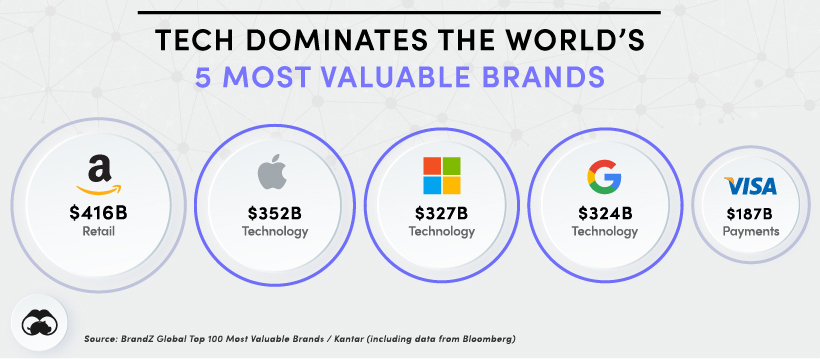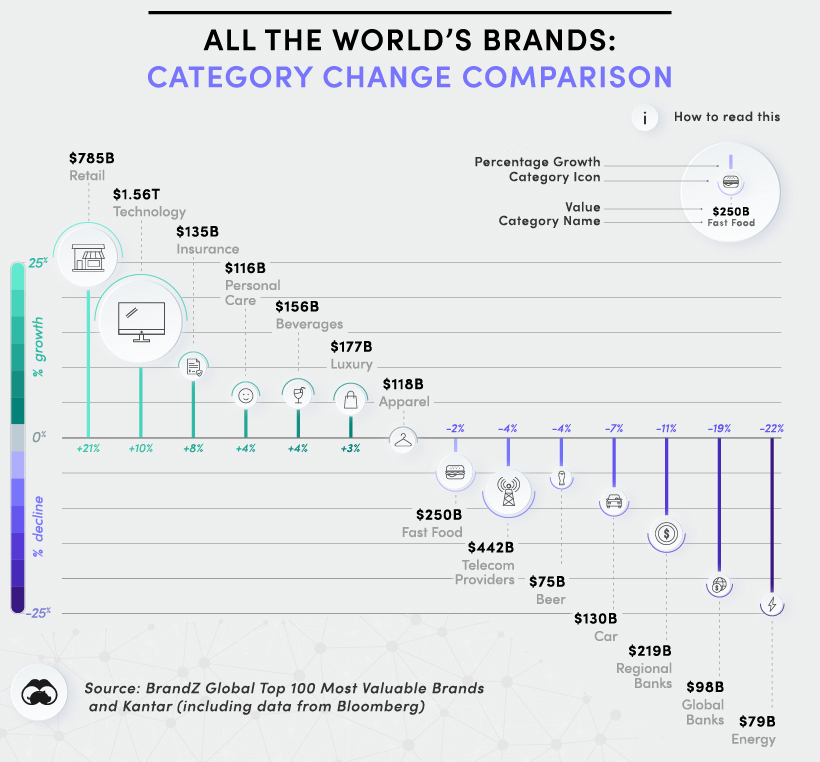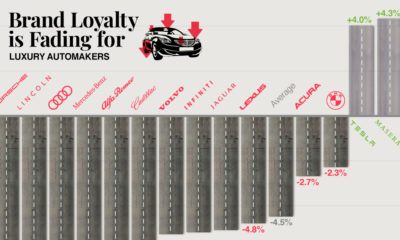Using data from Kantar and Bloomberg, a recent brand report released by BrandZ shows which tech companies are proving their worth to consumers during COVID-19 chaos. With data covering almost 4 million consumers, BrandZ also reveals that the tech sector leads the world’s 100 most valued brands in terms of financial power and consumer sentiment. Here’s how the top 20 tech brands from the report stack up: Out of the top five tech brands, Microsoft made the biggest moves with 30% brand value growth. Other big movers in the top 20 were Instagram (owned by Facebook), Adobe, and LinkedIn (owned by Microsoft), rising 47%, 29%, and 31%, respectively. Broken down by nation, U.S. brands are dominating tech’s heavy hitters, claiming 14 of the world’s top 20 tech brands. Chinese brands round out much of the remaining top 20, including tech entertainment and social media giant Tencent, which rose 15% in brand value since 2019.
Big Tech’s Heavyweights
Tech’s top brands are raking in billions of dollars, capturing consumer mindshare, captivating people, and comforting them during volatile months. Apple, Microsoft, Google, Tencent, and Facebook—tech’s leading contingent—have made those moves look easy during what are rough times for many world brands. While most tech brands in the upper half of the top 20 saw significant increases in brand value, only Facebook and IBM were in decline from 2019, at -7% and -3% respectively. The biggest loss in tech’s top 20 came from China’s Baidu, which fell by -29% in 2020. Waning consumer trust, thanks in part to the perceived misuse of personal data, is a gap that tech’s popularity alone won’t fill forever. (Following the Cambridge Analytica scandal, nearly 25% of Facebook account holders reported being “extremely” or “very” concerned about their personal data.)
Pandemic-Proof Applications
Coming in at eighth place, Facebook-owned Instagram gained 47% in brand value—a huge percentage, but less than the whopping 95% growth it had in 2019. On the whole, digital apps have been faring well during the pandemic, especially those built for entertainment, shopping, social connection, and delivery. — BrandZ 2020 Global Top 100 Report
Top Brands, by Category
With data collected into April 2020, BrandZ’s report on the world’s top 100 brands reflects multiple shifting needs and consumer concerns at a categorical scale.
While consumer affinity for e-commerce and social media brands has increased, fast food and beer brands took a hit, despite reports of increased alcohol consumption and food delivery during lockdown. It would seem then, that consumers have been valuing their tools and means of consumption. Of the report’s 14 brand categories, only six increased in value, mostly by less than 5%. Of the top risers, six were tech brands and six were mainly e-commerce. Other upwardly mobile brands were those in the apparel and personal care categories. Much like retail, those categories had an increasing reliance on technology to deliver their products.
The above chart shows overall categorical changes for 2020 led by retail, tech, and insurance. In the opposite corner, energy, and bank brands took the biggest hits.
Rolling with the Punches
The economic impacts of COVID-19 are undeniable. Even still, BrandZ’s top 100 brands marked a steady increase of 6% in value in 2020, compared to 7% the previous year. This pandemic has offered up era-defining change, with tech and e-commerce seizing the day. But in a climate where nothing can be taken for granted, brands large and small are still taking their knocks. For now, the brands that are embraced by consumers will be those that can apply a salve to the blows that 2020 keeps delivering. on But fast forward to the end of last week, and SVB was shuttered by regulators after a panic-induced bank run. So, how exactly did this happen? We dig in below.
Road to a Bank Run
SVB and its customers generally thrived during the low interest rate era, but as rates rose, SVB found itself more exposed to risk than a typical bank. Even so, at the end of 2022, the bank’s balance sheet showed no cause for alarm.
As well, the bank was viewed positively in a number of places. Most Wall Street analyst ratings were overwhelmingly positive on the bank’s stock, and Forbes had just added the bank to its Financial All-Stars list. Outward signs of trouble emerged on Wednesday, March 8th, when SVB surprised investors with news that the bank needed to raise more than $2 billion to shore up its balance sheet. The reaction from prominent venture capitalists was not positive, with Coatue Management, Union Square Ventures, and Peter Thiel’s Founders Fund moving to limit exposure to the 40-year-old bank. The influence of these firms is believed to have added fuel to the fire, and a bank run ensued. Also influencing decision making was the fact that SVB had the highest percentage of uninsured domestic deposits of all big banks. These totaled nearly $152 billion, or about 97% of all deposits. By the end of the day, customers had tried to withdraw $42 billion in deposits.
What Triggered the SVB Collapse?
While the collapse of SVB took place over the course of 44 hours, its roots trace back to the early pandemic years. In 2021, U.S. venture capital-backed companies raised a record $330 billion—double the amount seen in 2020. At the time, interest rates were at rock-bottom levels to help buoy the economy. Matt Levine sums up the situation well: “When interest rates are low everywhere, a dollar in 20 years is about as good as a dollar today, so a startup whose business model is “we will lose money for a decade building artificial intelligence, and then rake in lots of money in the far future” sounds pretty good. When interest rates are higher, a dollar today is better than a dollar tomorrow, so investors want cash flows. When interest rates were low for a long time, and suddenly become high, all the money that was rushing to your customers is suddenly cut off.” Source: Pitchbook Why is this important? During this time, SVB received billions of dollars from these venture-backed clients. In one year alone, their deposits increased 100%. They took these funds and invested them in longer-term bonds. As a result, this created a dangerous trap as the company expected rates would remain low. During this time, SVB invested in bonds at the top of the market. As interest rates rose higher and bond prices declined, SVB started taking major losses on their long-term bond holdings.
Losses Fueling a Liquidity Crunch
When SVB reported its fourth quarter results in early 2023, Moody’s Investor Service, a credit rating agency took notice. In early March, it said that SVB was at high risk for a downgrade due to its significant unrealized losses. In response, SVB looked to sell $2 billion of its investments at a loss to help boost liquidity for its struggling balance sheet. Soon, more hedge funds and venture investors realized SVB could be on thin ice. Depositors withdrew funds in droves, spurring a liquidity squeeze and prompting California regulators and the FDIC to step in and shut down the bank.
What Happens Now?
While much of SVB’s activity was focused on the tech sector, the bank’s shocking collapse has rattled a financial sector that is already on edge.
The four biggest U.S. banks lost a combined $52 billion the day before the SVB collapse. On Friday, other banking stocks saw double-digit drops, including Signature Bank (-23%), First Republic (-15%), and Silvergate Capital (-11%).
Source: Morningstar Direct. *Represents March 9 data, trading halted on March 10.
When the dust settles, it’s hard to predict the ripple effects that will emerge from this dramatic event. For investors, the Secretary of the Treasury Janet Yellen announced confidence in the banking system remaining resilient, noting that regulators have the proper tools in response to the issue.
But others have seen trouble brewing as far back as 2020 (or earlier) when commercial banking assets were skyrocketing and banks were buying bonds when rates were low.















